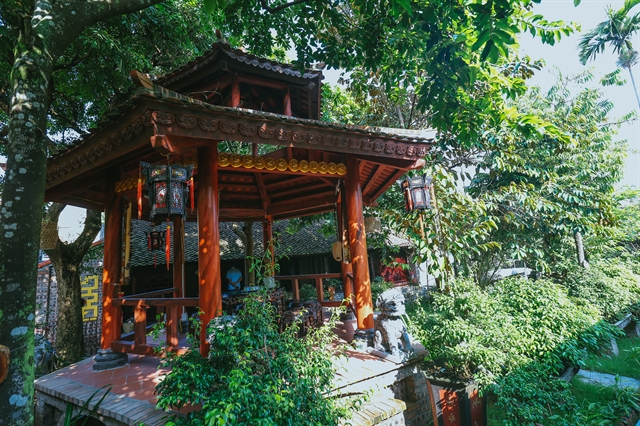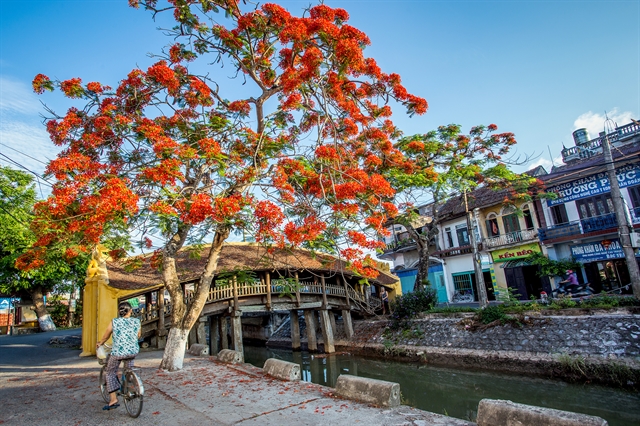Leaving the hustle and bustle of city life behind, I spent my weekend travelling to the northern province of Nam Định where I found serenity.

I was impressed with the peacefulness of Nam Định Province when I arrived. — Photo Phuong Thao / Shutterstock.com
Dương Hồng Tuấn
Leaving the hustle and bustle of city life behind, I spent my weekend travelling to the northern province of Nam Định where I found serenity.
The trip offered me a chance to explore the local culture and new tourism destinations.
After more than an hour driving from Hà Nội, I reached my first stop of the trip – Hồng Quang Village in Nam Trực District, one of three ancient villages that still practise the traditional water puppet in Việt Nam.

Nam Định Province is known as the home to many beautiful churches. — VNS Photo Dương Hồng Tuấn
According to Phan Văn Khỏe, the head of the water puppetry troupe in the district from 2002 to 2019, the ancient temple in the village worships Linh Ứng Đại Vương, the ancestor of water puppetry. Every five years, a festival is celebrated on the first 16th day of the lunar month to commemorate the ancestor of the art.
The master artist then explained to me the tricky process of making a puppet.
"The puppets are made from fig wood, painted with the resin of the lacquer tree and controlled in the water. To make a puppet, the puppeteer has to go through eight stages. The final product will be trimmed, polished and decorated with many paint colours to enhance its shape and the character that it features.
“Previously, on the big stage, the puppet controller used to soak in the water in hours, which seriously affected their health. Nowadays, with the modernisation in the stage set-up and puppet design, the performers can sit on the floor and control up to five puppets at the same time,” he said.
Experience local homestay
The next stop in my itinerary was a homestay in Hải Hậu District.
My first impression of the district was clean streets without any garbage. I couldn’t even see any trash cans on the side of the road. Instead, the two sides of the road were planted with colourful flowers.
Ecohost, the name of the homestay, is located in Đông Biên ancient town. The buildings in the town have typical old French-style architecture with 40cm-thick walls, low roofs and wooden floors.
The town is home to 19 such old houses whose structures are still intact since their construction in 1928.
After I stepped through the small gate of an old house, stretching in front of my eyes was a garden with many species of rare trees that are nearly 100 years old shading the large yard.
Both inside and outside of the house were many bamboo items, which are both nature-friendly and familiar to Vietnamese people.
Covering the whole space was stillness, which was sometimes enlivened with the sound of the birds chirping. I felt as if I was immersed in total serenity and my mind was refreshed after busy working days in the city.

In the middle of the garden is an octagonal pavilion where the visitors can enjoy tea while contemplate the moon at night. — VNS Photo Dương Hồng Tuấn
According to Bùi Thị Nhàn, the founder of the homestay, the accommodation combines traditional culture with modern services, allowing tourists to experience authentic local life.
While I was walking around the old house, another small garden appeared in front of my eyes. In the middle of the garden is an octagonal pavilion where the visitors can enjoy tea while contemplating the moon at night – an elegant hobby that a urbanite like me rarely get to experience.
Ancient bridge

The Chùa Lương Bridge, built in the 15th century, is one of the three most beautiful ancient tile-roofed bridges in Việt Nam. — VNS Photo Dương Hồng Tuấn
After a lunch of rustic country dishes, I took a break to prepare for a bicycle trip to Chùa Lương Bridge in the afternoon.
Departing at 2pm, I cycled on winding roads dotted with flowers, through the fields and along the poetic river, to reach the unique bridge.
Chùa Lương Bridge, built in the 15th century, is one of the three most beautiful ancient tile-roofed bridges in Việt Nam, besides Thanh Toàn Bridge in the central province of Thừa Thiên Huế and Chùa Bridge in the ancient town of Hội An in Quảng Nam Province.
The bridge looks like a house roofed over with tiles, lying across the river. It has a tiled roof complex with a full system of rafters like the design of a traditional Vietnamese house.
The local artisans utilised their creativity and talent to create a graceful bridge shaped like an ascending dragon.
Inside the bridge are two rows of corridors that are also curved along the bridge wall. It is where the pedestrians can stop and watch the flowing river below or the beautiful sunset on the whole village every evening.
Food exploration
My weekend escape ended with a food tour in Thành Nam ancient town in Nam Định City.
The must-try dish is phở bò (beef noodle soup) served at Tặng restaurant on Hàng Tiện Street. The dish had a aromatic, savoury broth with secret recipes of the family. Thinly sliced beef is pounded, dipped then picked out immediately to keep the freshness of the meat.
I also tried other local snacks like bánh nhãn (longan-shaped cake), peanut candy and bánh xíu páo (Char siu cake).
The latter dish entices with the aroma of char siu, the greasy taste of fatty pork, and the spice of pepper. I didn't forget to buy some char siu cakes for my relatives on the way back home.
Beautiful landscape, serene peacefulness and excellent food -- all of these made my two-day trip to Nam Định so fulfilling. VNS